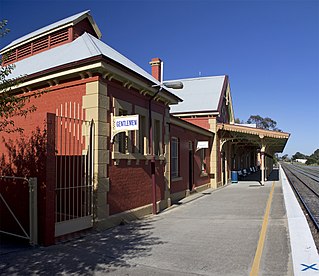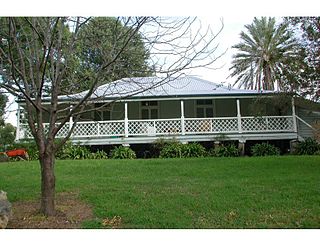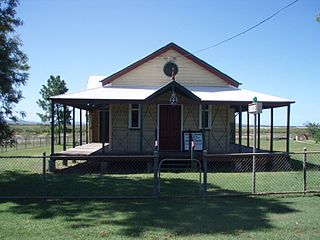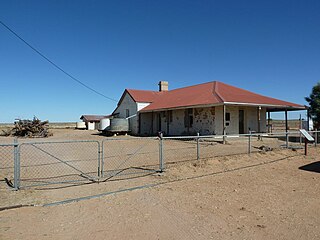
Queanbeyan railway station is a heritage-listed railway station located on the Bombala line in New South Wales, Australia. It serves the town of Queanbeyan.

Canning Downs was the first residential establishment built by a white person on the Darling Downs in Queensland, Australia. It is located a short drive from the town of Warwick and originally extended south east to Killarney and the McPherson Range. The area was first named after the British statesman George Canning by Allan Cunningham.

Armidale railway station is a heritage-listed railway station at 240 Brown Street, Armidale, Armidale Regional Council, New South Wales, Australia. It was built from 1882 to 1883 by Edmund Lonsdale and Henry Sheldon Hoddard, and was opened on 3 February 1883 when the line was extended from Uralla. It was the terminus of the line until it was extended to Glen Innes on 19 August 1884. It was added to the New South Wales State Heritage Register on 2 April 1999.

Mitchell railway station is located on the Western line in the Maranoa Region, Queensland, Australia. It serves the town of Mitchell. The station has one platform, opening in 1885. The station has a number of heritage-listed buildings, including the passenger station in Oxford Street, the goods shed in Alice Street, and the station master's house in Sheffield Street. The buildings were added to Queensland Heritage Register on 8 September 2005.

Jondaryan Homestead is a heritage-listed homestead at Evanslea Road, Jondaryan, Toowoomba Region, Queensland, Australia. It was the base of the former Jondaryan pastoral station, which was originally taken up in 1840, and at one time was the largest freehold station in Queensland. The site contains the current house, which was built after the original was destroyed by fire in 1937, the original kitchen dating from 1844, and a kitchen, butcher's shop, shearer's quarters, stables, dairy, toilet block and store, many dating from the 1860s. It also contains the remains of horse stalls, a slaughterhouse, hide store, and Chinese gardener's glasshouse. It was added to the Queensland Heritage Register on 21 October 1992.

Lytton Quarantine Station is a heritage-listed former quarantine station at 160 South Street, Lytton, City of Brisbane, Queensland, Australia. It was built from 1913 to c. 1914. It is also known as Customs Reserve and Lytton Quarantine Complex and Animal Detention Centre. It is included within the Fort Lytton National Park. It was added to the Queensland Heritage Register on 22 September 2000.

Maryborough railway station is a heritage-listed railway station at Lennox Street, Maryborough, Fraser Coast Region, Queensland, Australia. It is on the North Coast line serving the city of Maryborough. It was designed by Chief Engineer of the Queensland Railways Department and built from 1878 to 1890 by John Roddam & John Walker. It was added to the Queensland Heritage Register on 21 October 1992.

The Border Bridge is a road bridge over the Macintyre River in Goondiwindi, Queensland, Australia. The bridge has no official name so it is also referred to as Goondiwindi Bridge or Macintyre River Bridge. The previous bridge, built before Australian federation, was the main hub for freight crossing the border between New South Wales and Queensland, where duties were collected by Customs.

Ballandean Homestead is a heritage-listed homestead at Ballandean, Southern Downs Region, Queensland, Australia. It was built from c. 1840 to 1890s circa. It was added to the Queensland Heritage Register on 21 October 1992.

Warwick railway station is a heritage-listed railway station on the Southern railway line in Warwick, Southern Downs Region, Queensland, Australia. It was built from c. 1881 to 1910s. It was added to the Queensland Heritage Register on 24 September 1999.

Gracemere Homestead is a heritage-listed homestead at 234 Gracemere Road, Gracemere, Rockhampton Region, Queensland, Australia. It was built from 1858 to 1890s. It was added to the Queensland Heritage Register on 21 October 1992.

Nebo Hotel, also known as Fort Cooper Hotel, is a heritage-listed hotel at 2 Reynolds Street, Nebo, Isaac Region, Queensland, Australia. It was built in 1886 and was added to the Queensland Heritage Register on 27 October 2000.

St Lawrence Police Station is a heritage-listed police station and former courthouse at Macartney Street, St Lawrence, Isaac Region, Queensland, Australia. It was built from 1878 to 1934. It is also known as former St Lawrence Courthouse and Cell Block. It was added to the Queensland Heritage Register on 24 November 2000.

McCowat's Farm is a heritage-listed plantation at McCowat Road, Garradunga, Cassowary Coast Region, Queensland, Australia. It was built in 1920 by William Purdy. It is also known as Koodla. It was added to the Queensland Heritage Register on 21 October 1992.

Ravenswood Court House and Police Station is a heritage-listed former courthouse and police station at Raven Street, Ravenswood, Charters Towers Region, Queensland, Australia. They were designed by the Queensland Department of Public Works and were built in 1882 by A Donald and FA Sparre. They are also known as Ravenswood Court House Group. They were added to the Queensland Heritage Register on 27 January 1994.

Croydon Police Station is a heritage-listed former police station at Samwell Street, Croydon, Shire of Croydon, Queensland, Australia. It was built in 1899. It is also known as Former Police Station and Residence. It was added to the Queensland Heritage Register on 23 July 1999.

Tarong Homestead is a heritage-listed homestead at Cooyar Road, Tarong, South Burnett Region, Queensland, Australia. It was built from 1840s circa to 1890s circa. It was added to the Queensland Heritage Register on 21 October 1992.

Langenbaker House is a heritage-listed detached house at Mitchell Street, Ilfracombe, Longreach Region, Queensland, Australia. It was erected in Ilfracombe in 1899, but was originally built earlier at another location. It was added to the Queensland Heritage Register on 29 November 2001.

Birdsville Courthouse is a heritage-listed courthouse at Adelaide Street, Birdsville, Shire of Diamantina, Queensland, Australia. It was designed by the Queensland Department of Works and built from 1888 to 1890 by J Wookey and Henry Walton. It was added to the Queensland Heritage Register on 21 October 1992.

Cameron Corner Survey Marker is a heritage-listed survey marker in the locality of Cameron Corner, Shire of Bulloo, Queensland, Australia. The survey marker is at the border corner of South-West Queensland with New South Wales and South Australia; it was established in 1880. It was added to the Queensland Heritage Register on 9 November 2012.























